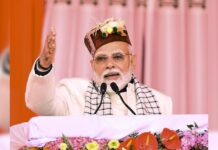NEW DELHI: The coronavirus pandemic has pushed the education system online, a challenge that could test the schools’ ability to provide quality learning for all. Digital technology replaces face-to-face teaching, paving the way for visual learning and delivering lessons to children at home.
The COVID-19 crisis has already initiated the change in the conventional approach to education and presents an opportunity for teachers to deploy innovations during the outbreak for a lasting change, where technologies will play a bigger role in schools in the future.
The schools are using existing platforms from the likes of Microsoft and Google as well as the conferencing apps like Zoom to conduct classroom programs for their pupils. Speaking to IANS on the essence of design of the e-learning program for children, Manju Sethi, Principal Bluebells School International, said “The school has adopted e-learning to engage children meaningfully – both physically and emotionally. Lessons are made interesting for children and we encourage them to become independent learners. The school is already equipped with digital learning — teachers’ have been trained on Microsoft apps. We have adopted the universal backward design module. We have also trained teachers to explore digital platforms. Learning at home is an opportunity for the child.”
Digital learning also focuses on establishing connectivity between children, while they participate in the e-learning program. The program also helps in developing communication among the children. Especially in completing digitally designed classroom assignments, for example story telling in primary classes.
Monica Sagar, Principal, Shiv Nadar School, Gurugram, said the Shiv Nadar schools have been using online platforms since March 16 to hold scholastic classes and co-scholastic appreciation sessions; share annual academic results. “Held orientations to the new sections; give an e-farewell to staff transferring out of school; have an SMC meeting and have confluences as well as training sessions for staff. We have ensured that teaching and learning and other school activities do not suffer owing to the lockdown” said Sagar.
Apeejay School International Principal Ritu Mehta said, “Through digital learning home becomes school and school goes beyond learning, as lessons are planned technologically. We have developed a time table for the students to learn while they are home. Teachers at the school are already technology savvy. In the digital curriculum teachers develop powerpoint presentations to engage children. Visual learning will replace theoretical learning, in fact this is the future and we are already preparing for it. Since March 11, we have already rolled out digital classroom contact module for class 10 and 12 students.”
Shweta Verma’s children attend Amity International School Saket, said amidst such crisis – a ray of hope “online school”. “My kids go to Amity Saket & have been attending classes through a digital portal for the last 2-3 weeks. Extremely happy the way it has shaped up, teachers & students are full of zeal, teaching methodology works so very well – seems like students are taking classes in brick & mortar,” said Verma.
Juhi Tandon, whose children attend K R Mangalam World School, said she is extremely happy with the e-learning module of the school. “It is a great effort by the school as the students of the secondary section are not missing on their academic curriculum”, added Tandon.







